Submitted:
21 June 2023
Posted:
22 June 2023
You are already at the latest version
Abstract

Keywords:
1. Introduction
2. Materials and Methods
2.1. City Selection Criteria
2.1.1. Location and Observation of DST
2.1.2. Population and Traffic Congestion
2.2. Selection of Time Periods
2.3. Generation of Work Schedule Data
2.4. Generation of School Schedule Data
2.5. Modeling Time Change Arrangements in SAFTE-FAST
2.6. Statistical Analysis
3. Results
3.1. Schedule Descriptive Statistics
3.2. Time Change Arrangements and Exposure to Daylight
3.3. Time Change Arrangements and Predicted Effectiveness
3.4. Time Change Arrangements and Rush Hour Commutes
4. Discussion
5. Conclusions
Supplementary Materials
Author Contributions
Funding
Institutional Review Board Statement
Informed Consent Statement
Data Availability Statement
Conflicts of Interest
References
- Clark, C.E. , Cunningham, Lynn J. Daylight Saving Time. 2020. [Google Scholar]
- Government. Public Law 109 - 58 - Energy Policy Act of 2005. 2005.
- Congress. S.623 117th Congress (2021-2022): Sunshine Protection Act of 2021. 2022. Available online: https://www.congress.gov/bill/117th-congress/senate-bill/623.
- Rishi, M.A.; Ahmed, O.; Barrantes Perez, J.H.; Berneking, M.; Dombrowsky, J.; Flynn-Evans, E.E.; Santiago, V.; Sullivan, S.S.; Upender, R.; Yuen, K. Daylight saving time: an American Academy of Sleep Medicine position statement. Journal of clinical sleep medicine 2020, 16, 1781–1784. [Google Scholar] [CrossRef]
- Roenneberg, T.; Winnebeck, E.C.; Klerman, E.B. Daylight saving time and artificial time zones–a battle between biological and social times. Frontiers in Physiology 2019, 944. [Google Scholar] [CrossRef] [PubMed]
- Roenneberg, T.; Wirz-Justice, A.; Skene, D.J.; Ancoli-Israel, S.; Wright, K.P.; Dijk, D.-J.; Zee, P.; Gorman, M.R.; Winnebeck, E.C.; Klerman, E.B. Why should we abolish daylight saving time? Journal of biological rhythms 2019, 34, 227–230. [Google Scholar] [CrossRef]
- Kotchen, M.J.; Grant, L.E. Does daylight saving time save energy? Evidence from a natural experiment in Indiana. Review of Economics and Statistics 2011, 93, 1172–1185. [Google Scholar] [CrossRef]
- Hill, S.; Desobry, F.; Garnsey, E.; Chong, Y.-F. The impact on energy consumption of daylight saving clock changes. Energy Policy 2010, 38, 4955–4965. [Google Scholar] [CrossRef]
- Belzer, D.; Hadley, S.; Chin, S.-M. Impact of extended daylight saving time on national energy consumption report to congress; DOEEE (USDOE Office of Energy Efficiency and Renewable Energy (EE)), 2008. [Google Scholar]
- Filliben, J.; Bartky, I.; Ku, H.; Oser, H. Review and technical evaluation of the DOT daylight saving time study. reporte técnico, US National Bureau of Standards, NBS Internal Report Prepared for the Chairman Subcommittee on Transportation and Commerce, Committee on Interstate and Foreign Commerce, US House of Representatives, KF27. I 1976, 5589. [Google Scholar]
- Zick, C.D. Does daylight savings time encourage physical activity? Journal of physical activity and health 2014, 11, 1057–1060. [Google Scholar] [CrossRef]
- Goodman, A.; Page, A.S.; Cooper, A.R. Daylight saving time as a potential public health intervention: an observational study of evening daylight and objectively-measured physical activity among 23,000 children from 9 countries. International Journal of Behavioral Nutrition and Physical Activity 2014, 11, 1–9. [Google Scholar] [CrossRef]
- Rosenberg, M.; Wood, L. The power of policy to influence behaviour change: daylight saving and its effect on physical activity. Australian and New Zealand journal of public health 2010, 34, 83–88. [Google Scholar] [CrossRef]
- Calandrillo, S.P.; Buehler, D.E. Time well spent: An economic analysis of daylight saving time legislation. Wake Forest L. Rev. 2008, 43, 45. [Google Scholar]
- Kamstra, M.J.; Kramer, L.A.; Levi, M.D. Losing sleep at the market: The daylight saving anomaly. American Economic Review 2000, 90, 1005–1011. [Google Scholar] [CrossRef]
- Fritz, J.; VoPham, T.; Wright Jr, K.P.; Vetter, C. A chronobiological evaluation of the acute effects of daylight saving time on traffic accident risk. Current biology 2020, 30, 729–735.e722. [Google Scholar] [CrossRef] [PubMed]
- Bünnings, C.; Schiele, V. Spring forward, don’t fall back: The effect of daylight saving time on road safety. Review of Economics and Statistics 2021, 103, 165–176. [Google Scholar] [CrossRef]
- Carey, R.N.; Sarma, K.M. Impact of daylight saving time on road traffic collision risk: a systematic review. BMJ open 2017, 7, e014319. [Google Scholar] [CrossRef]
- Herd, D.R.; Agent, K.R.; Rizenbergs, R.L. Traffic accidents: Day versus night. 1980.
- Laliotis, I.; Moscelli, G.; Monastiriotis, V. Summertime and the drivin’is easy? Daylight Saving Time and vehicle accidents. Daylight Saving Time and Vehicle Accidents (December 31, 2019). LSE ‘Europe in Question’Discussion Paper Series, LEQS Paper, 2019. [Google Scholar]
- Wright Jr, K.P.; McHill, A.W.; Birks, B.R.; Griffin, B.R.; Rusterholz, T.; Chinoy, E.D. Entrainment of the human circadian clock to the natural light-dark cycle. Current Biology 2013, 23, 1554–1558. [Google Scholar] [CrossRef]
- Hashizaki, M.; Nakajima, H.; Shiga, T.; Tsutsumi, M.; Kume, K. A longitudinal large-scale objective sleep data analysis revealed a seasonal sleep variation in the Japanese population. Chronobiology international 2018, 35, 933–945. [Google Scholar] [CrossRef]
- Harrison, Y. The impact of daylight saving time on sleep and related behaviours. Sleep medicine reviews 2013, 17, 285–292. [Google Scholar] [CrossRef] [PubMed]
- Meltzer, L.J.; Plog, A.E.; Wahlstrom, K.L.; Strand, M.J. Biology vs. Ecology: A Longitudinal Examination of Sleep, Development, and a Change in School Start Times. Sleep Medicine 2022. [Google Scholar] [CrossRef]
- Ziporyn, T.D.; Owens, J.A.; Wahlstrom, K.L.; Wolfson, A.R.; Troxel, W.M.; Saletin, J.M.; Rubens, S.L.; Pelayo, R.; Payne, P.A.; Hale, L. Adolescent sleep health and school start times: Setting the research agenda for California and beyond: A research summit summary: A research summit summary. Sleep Health 2022, 661. [Google Scholar] [CrossRef]
- Meltzer, L.J.; Wahlstrom, K.L.; Plog, A.E.; Strand, M.J. Changing school start times: impact on sleep in primary and secondary school students. Sleep 2021, 44, zsab048. [Google Scholar] [CrossRef] [PubMed]
- Bin-Hasan, S.; Kapur, K.; Rakesh, K.; Owens, J. School start time change and motor vehicle crashes in adolescent drivers. Journal of clinical sleep medicine 2020, 16, 371–376. [Google Scholar] [CrossRef] [PubMed]
- Collins, T.A.; Indorf, C.; Klak, T. Creating regional consensus for starting school later: a physician-driven approach in southern Maine. Sleep Health 2017, 3, 479–482. [Google Scholar] [CrossRef] [PubMed]
- Statistics, U.B.o.L. Job flexibilities and work schedules summary. 2019.
- Lerman, S.E.; Eskin, E.; Flower, D.J.; George, E.C.; Gerson, B.; Hartenbaum, N.; Hursh, S.R.; Moore-Ede, M. Fatigue risk management in the workplace. Journal of Occupational and Environmental Medicine 2012, 54, 231–258. [Google Scholar] [CrossRef] [PubMed]
- Åkerstedt, T.; Wright, K.P. Sleep loss and fatigue in shift work and shift work disorder. Sleep medicine clinics 2009, 4, 257–271. [Google Scholar] [CrossRef]
- Kantermann, T. Challenging the human circadian clock by Daylight Saving Time and Shift-Work. lmu, 2008. [CrossRef]
- Hursh, S.R.; Redmond, D.P.; Johnson, M.L.; Thorne, D.R.; Belenky, G.; Balkin, T.J.; Storm, W.F.; Miller, J.C.; Eddy, D.R. Fatigue models for applied research in warfighting. Aviation, space, and environmental medicine 2004, 75, A44–A53. [Google Scholar]
- Hursh, S.R.; Balkin, T.J.; Miller, J.C.; Eddy, D.R. The fatigue avoidance scheduling tool: Modeling to minimize the effects of fatigue on cognitive performance; SAE Transactions 113 (1), 111–119. [CrossRef]
- Roma, P.G.; Hursh, S.R.; Mead, A.M.; Nesthus, T.E. Flight attendant work/rest patterns, alertness, and performance assessment: Field validation of biomathematical fatigue modeling; Federal Aviation Administration Oklahoma City Ok Civil Aerospace Medical Inst, 2012. [Google Scholar]
- Dawson, D.; Reid, K. Fatigue, alcohol and performance impairment. Nature 1997, 388, 235–235. [Google Scholar] [CrossRef]
- Arnedt, J.T.; Wilde, G.J.; Munt, P.W.; MacLean, A.W. How do prolonged wakefulness and alcohol compare in the decrements they produce on a simulated driving task? Accident Analysis & Prevention 2001, 33, 337–344. [Google Scholar]
- Devine, J.K.; Garcia, C.R.; Simoes, A.S.; Guelere, M.R.; de Godoy, B.; Silva, D.S.; Pacheco, P.C.; Choynowski, J.; Hursh, S.R. Predictive Biomathematical Modeling Compared to Objective Sleep During COVID-19 Humanitarian Flights. Aerospace Medicine and Human Performance 2022, 93, 4–12. [Google Scholar] [CrossRef]
- Schwartz, L.P.; Devine, J.K.; Hursh, S.R.; Mosher, E.; Schumacher, S.; Boyle, L.; Davis, J.E.; Smith, M.; Fitzgibbons, S.C. Biomathematical modeling predicts fatigue risk in general surgery residents. Journal of surgical education 2021, 78, 2094–2101. [Google Scholar] [CrossRef]
- Gertler, J.; Hursh, S.; Fanzone, J.; Raslear, T.; America, Q.N. Validation of FAST model sleep estimates with actigraph measured sleep in locomotive engineers; United States. Federal Railroad Administration, 2012. [Google Scholar]
- Hursh, S.R.; Fanzone, J.F.; Raslear, T.G. Analysis of the Relationship between Operator Effectiveness Measures and Economic Impacts of Rail Accidents (Technial Report DOT/FRA/ORD-11/13); U.S. Department of Transportation: Washington, DC, USA, 2011. [Google Scholar]
- Register, F. 49 CFR Part 228; Hours of Service of Railroad Employees; Substantive Regulations for Train Employees Providing Commuter and Intercity Rail Passenger Transportation; Conforming Amendments to Recordkeeping Requirements; Final Rule. 76 FR 50359. Available online: https://www.federalregister.gov/documents/2011/08/12/2011-20290/hours-of-service-of-railroad-employees-substantive-regulations-for-train-employees-providing (accessed on.
- Pruchnicki, S.A.; Wu, L.J.; Belenky, G. An exploration of the utility of mathematical modeling predicting fatigue from sleep/wake history and circadian phase applied in accident analysis and prevention: the crash of Comair Flight 5191. Accident Analysis & Prevention 2011, 43, 1056–1061. [Google Scholar]
- Hursh, S.R.; Raslear, T.G.; Kaye, A.S.; Fanzone, J.F. Validation and calibration of a fatigue assessment tool for railroad work schedules, summary report. (Report No. DOT/ FRA/ORD–06/21); Federal Railroad Administration: Washington, DC, USA, 2006. [Google Scholar]
- NCSL. Daylight Saving Time | State Legislation. Available online: https://www.ncsl.org/research/transportation/daylight-savings-time-state-legislation.aspx (accessed on 4/19/2022).
- Brock, T.D. Calculating solar radiation for ecological studies. Ecological modelling 1981, 14, 1–19. [Google Scholar] [CrossRef]
- Woolf, H.M. On the computation of solar elevation angles and the determination of sunrise and sunset times; National Aeronautics and Space Administration, 1968. [Google Scholar]
- Forsythe, W.C.; Rykiel Jr, E.J.; Stahl, R.S.; Wu, H.-i.; Schoolfield, R.M. A model comparison for daylength as a function of latitude and day of year. Ecological Modelling 1995, 80, 87–95. [Google Scholar] [CrossRef]
- NIST. The Official U.S. Time. Available online: https://www.time.gov/ (accessed on 4/19/2022).
- UTA. Uniform Time Act of 1966 (15 U.S.C. §§ 260-64) 1966.
- NHTSA. State Traffic Safety Information. Available online: https://cdan.nhtsa.gov/stsi.htm (accessed on 4/19/2022).
- Management, O.o.; Budget. 2010 standards for delineating metropolitan and micropolitan statistical areas. Federal Register 2010, 75, 37246–37252. [Google Scholar]
- Average number of hours in the school day and average number of days in the school year for public schools, by state: 2007–08. Available online: https://nces.ed.gov/surveys/sass/tables/sass0708_035_s1s.asp (accessed on 29 April 2022).
- Wheaton, A.G.F.; , Gabrielle A; Croft, Janet B. School Start Times for Middle School and High School Students — United States, 2011–12 School Year. Available online: https://www.cdc.gov/mmwr/preview/mmwrhtml/mm6430a1.htm?s_cid=mm6430a1_w (accessed on 29 April 2022).
- Hursh, S.R. System and method for evaluating task effectiveness based on sleep pattern. 2003.
- Hursh, S.; Gertler, J.; Raslear, T. Measurement and Estimation of Sleep in Railroad Worker Employees. Research Results 2011. [Google Scholar]
- SunEarthTools.com. Sunrise Sunset Calendar. Available online: https://www.sunearthtools.com/solar/sunrise-sunset-calendar.php#top (accessed on 24 May 2022).
- Schmider, E.; Ziegler, M.; Danay, E.; Beyer, L.; Bühner, M. Is it really robust? Reinvestigating the robustness of ANOVA against violations of the normal distribution assumption. Methodology: European Journal of Research Methods for the Behavioral and Social Sciences 2010, 6, 147. [Google Scholar] [CrossRef]
- Rogan, J.C.; Keselman, H. Is the ANOVA F-test robust to variance heterogeneity when sample sizes are equal?: An investigation via a coefficient of variation. American Educational Research Journal 1977, 14, 493–498. [Google Scholar] [CrossRef]
- Cohen, J. Statistical power analysis for the behavioral sciences; Routledge, 2013. [Google Scholar]
- Fritz, C.O.; Morris, P.E.; Richler, J.J. Effect size estimates: current use, calculations, and interpretation. Journal of experimental psychology: General 2012, 141, 2. [Google Scholar] [CrossRef]
- Lakens, D. Calculating and reporting effect sizes to facilitate cumulative science: a practical primer for t-tests and ANOVAs. Frontiers in psychology 2013, 4, 863. [Google Scholar] [CrossRef]
- Register, F. 49 CFR Part 228; Hours of Service of Railroad Employees. 2011.
- Lahti, T.; Nysten, E.; Haukka, J.; Sulander, P.; Partonen, T. Daylight Saving Time Transitions and Road Traffic Accidents. Journal of Environmental and Public Health 2010, 2010, 657167. [Google Scholar] [CrossRef]
- Robb, D.; Barnes, T. Accident rates and the impact of daylight saving time transitions. Accident Analysis & Prevention 2018, 111, 193–201. [Google Scholar]
- Lambe, M.; Cummings, P. The shift to and from daylight savings time and motor vehicle crashes. Accident Analysis & Prevention 2000, 32, 609–611. [Google Scholar]
- Watson, N.F. Time to show leadership on the daylight saving time debate. 2019, 15, 815–817. [Google Scholar] [CrossRef]
- Fotios, S.; Robbins, C.J.; Uttley, J. A comparison of approaches for investigating the impact of ambient light on road traffic collisions. Lighting Research & Technology 2021, 53, 249–261. [Google Scholar]
- Raynham, P.; Unwin, J.; Khazova, M.; Tolia, S. The role of lighting in road traffic collisions. Lighting Research & Technology 2020, 52, 485–494. [Google Scholar]
- Skeldon, A.C.; Phillips, A.J.; Dijk, D.-J. The effects of self-selected light-dark cycles and social constraints on human sleep and circadian timing: a modeling approach. Scientific reports 2017, 7, 1–14. [Google Scholar] [CrossRef] [PubMed]
- Wittmann, M.; Dinich, J.; Merrow, M.; Roenneberg, T. Social jetlag: misalignment of biological and social time. Chronobiology international 2006, 23, 497–509. [Google Scholar] [CrossRef]
- McMahon, D.M.; Burch, J.B.; Wirth, M.D.; Youngstedt, S.D.; Hardin, J.W.; Hurley, T.G.; Blair, S.N.; Hand, G.A.; Shook, R.P.; Drenowatz, C. Persistence of social jetlag and sleep disruption in healthy young adults. Chronobiology international 2018, 35, 312–328. [Google Scholar] [CrossRef]
- Owens, J.A.; Dearth-Wesley, T.; Lewin, D.; Gioia, G.; Whitaker, R.C. Self-regulation and sleep duration, sleepiness, and chronotype in adolescents. Pediatrics 2016, 138. [Google Scholar] [CrossRef]
- Legislation. Available online: https://www.startschoollater.net/legislation.html (accessed on 3 June 2022).
- Watson, N.F.; Martin, J.L.; Wise, M.S.; Carden, K.A.; Kirsch, D.B.; Kristo, D.A.; Malhotra, R.K.; Olson, E.J.; Ramar, K.; Rosen, I.M. Delaying middle school and high school start times promotes student health and performance: an American Academy of Sleep Medicine position statement. Journal of Clinical Sleep Medicine 2017, 13, 623–625. [Google Scholar] [CrossRef]
- Skeldon, A.C.; Dijk, D.-J. School start times and daylight saving time confuse California lawmakers. Current Biology 2019, 29, R278–R279. [Google Scholar] [CrossRef]
- Gentry, J.; Evaniuck, J.; Suriyamongkol, T.; Mali, I. Living in the wrong time zone: Elevated risk of traffic fatalities in eccentric time localities. Time & Society 2022, 0961463X221104675. [Google Scholar]
- AP-NORC. Dislike for changing the clocks persists. Available online: http://apnorc.org/projects/dislike-for-changing-the-clocks-persists (accessed on 9 June 2022).
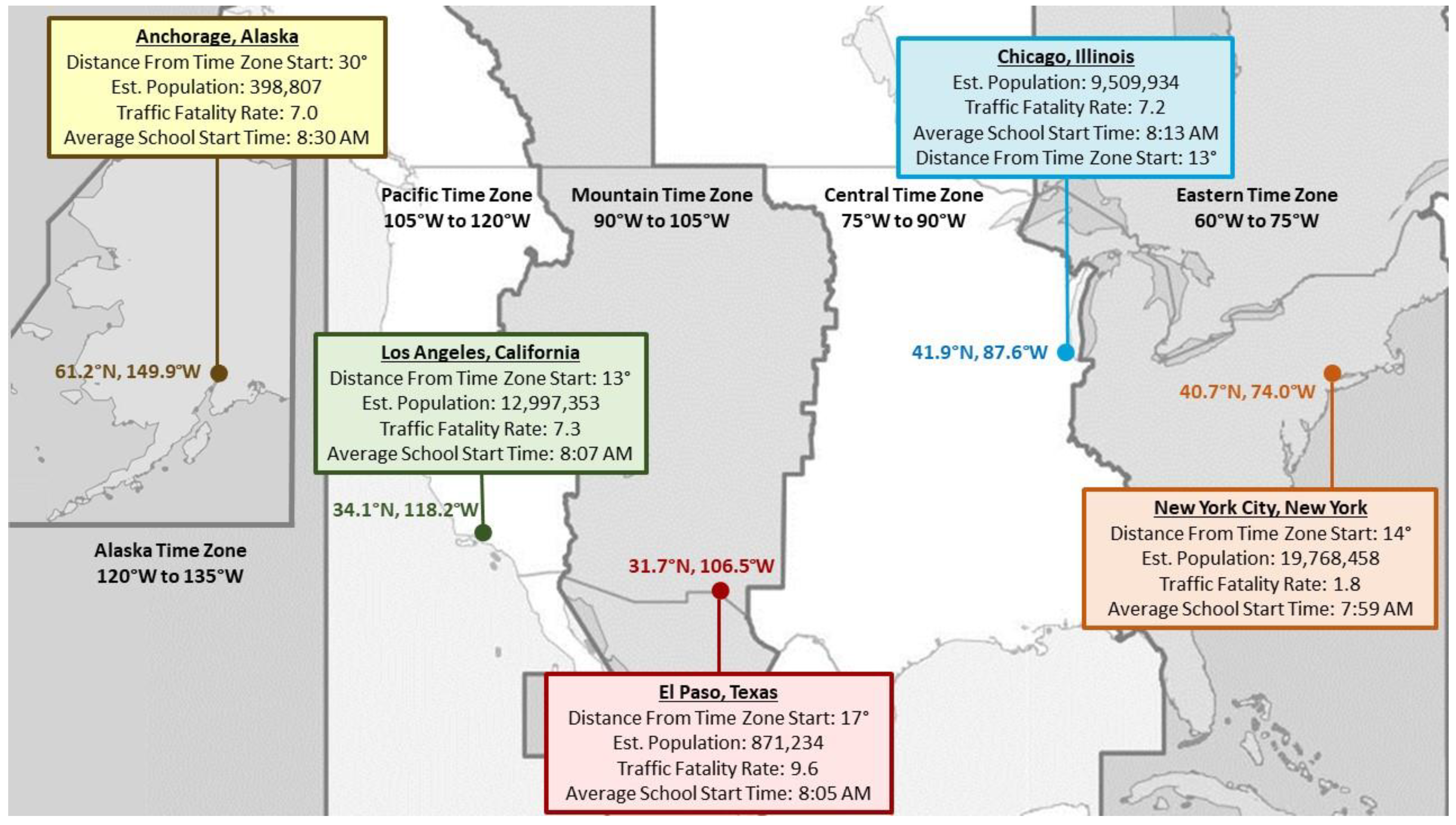
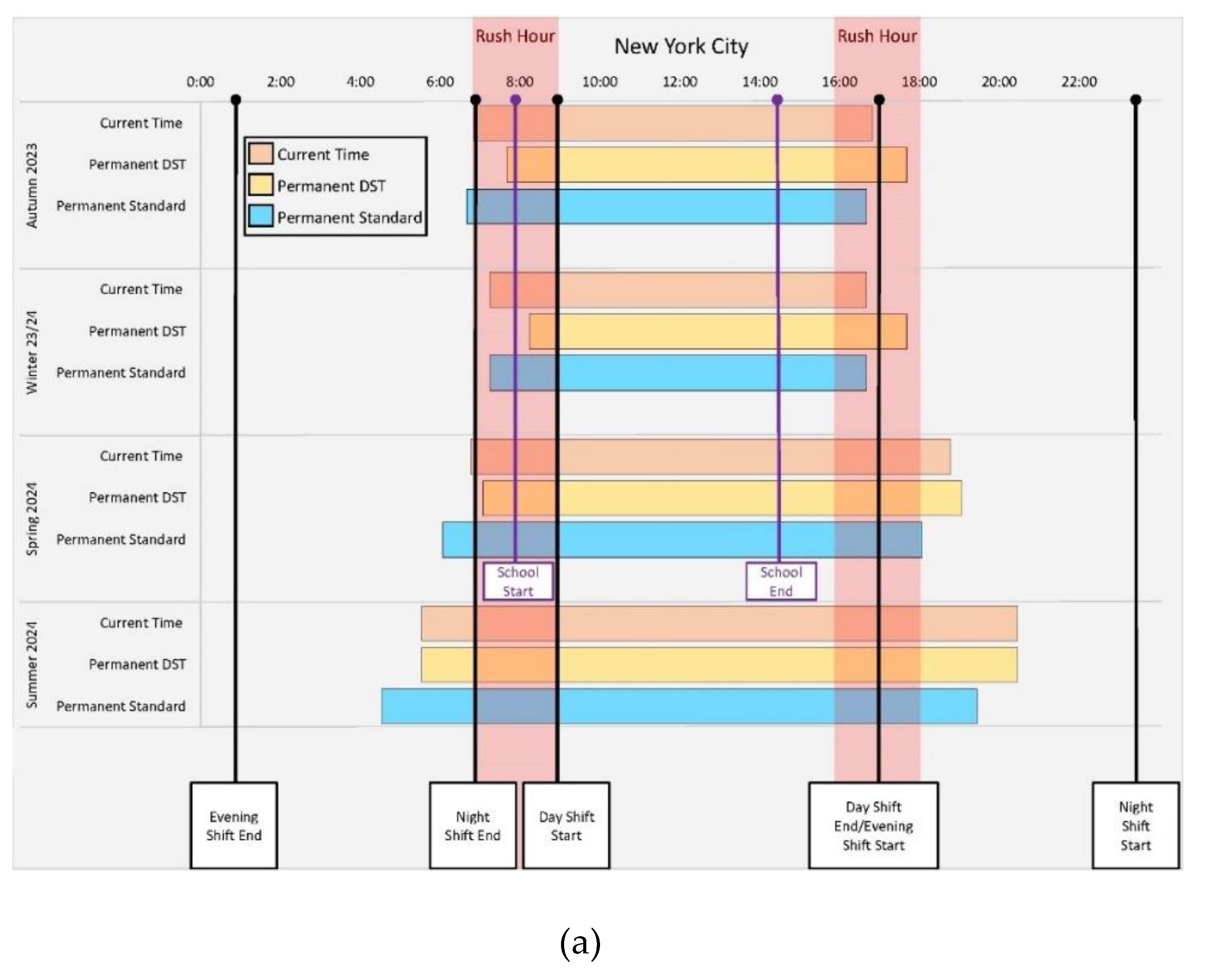
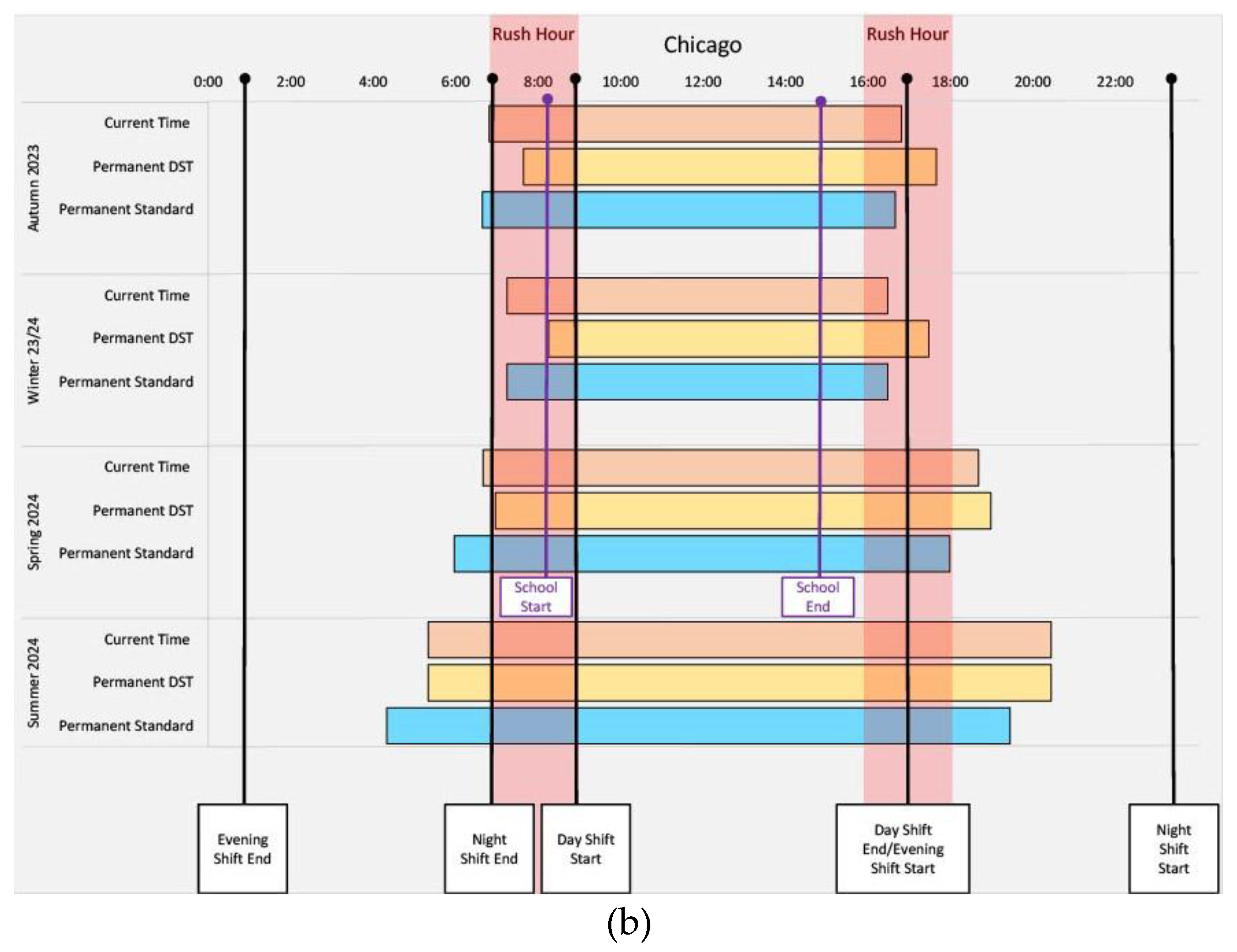
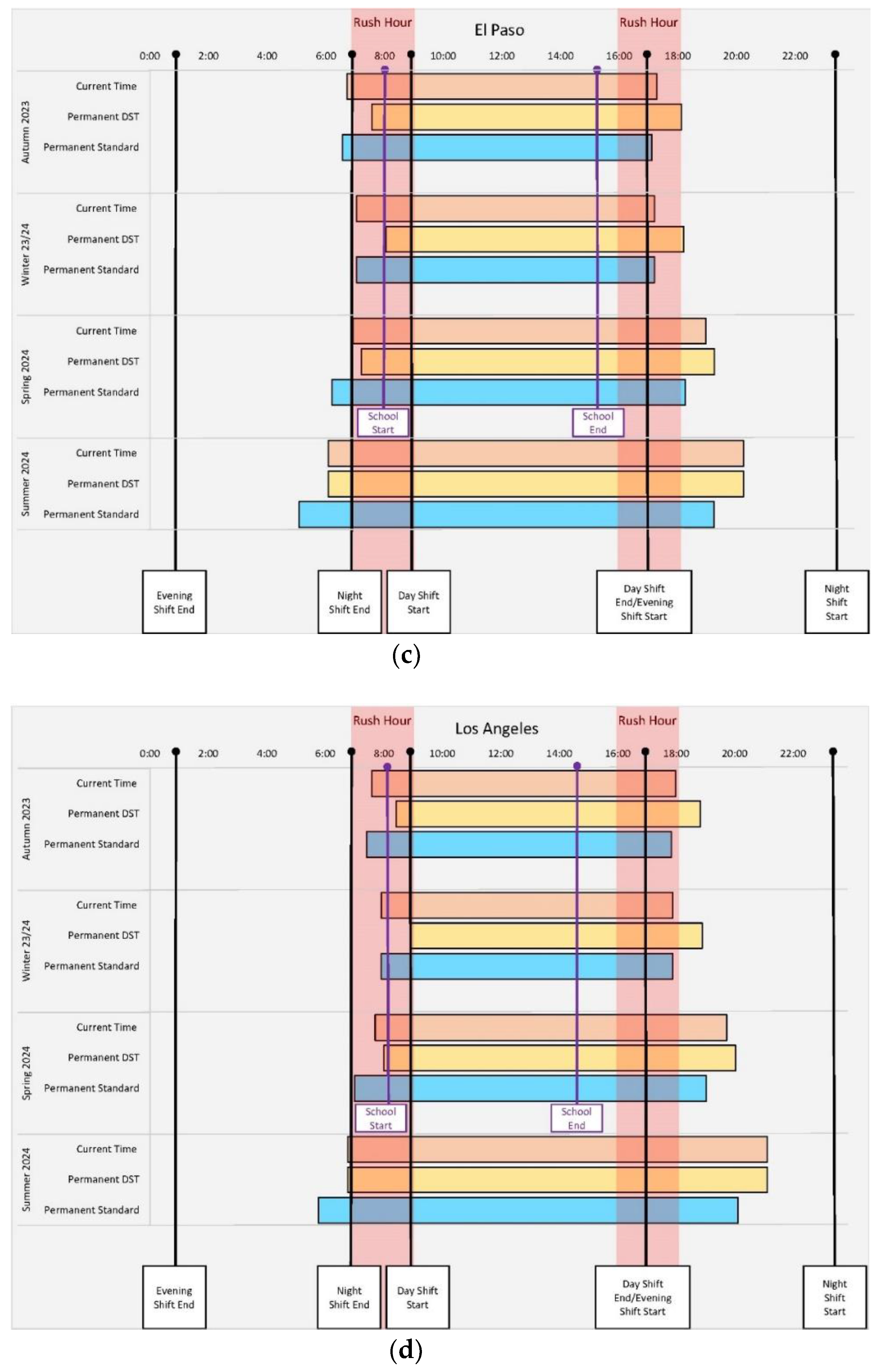
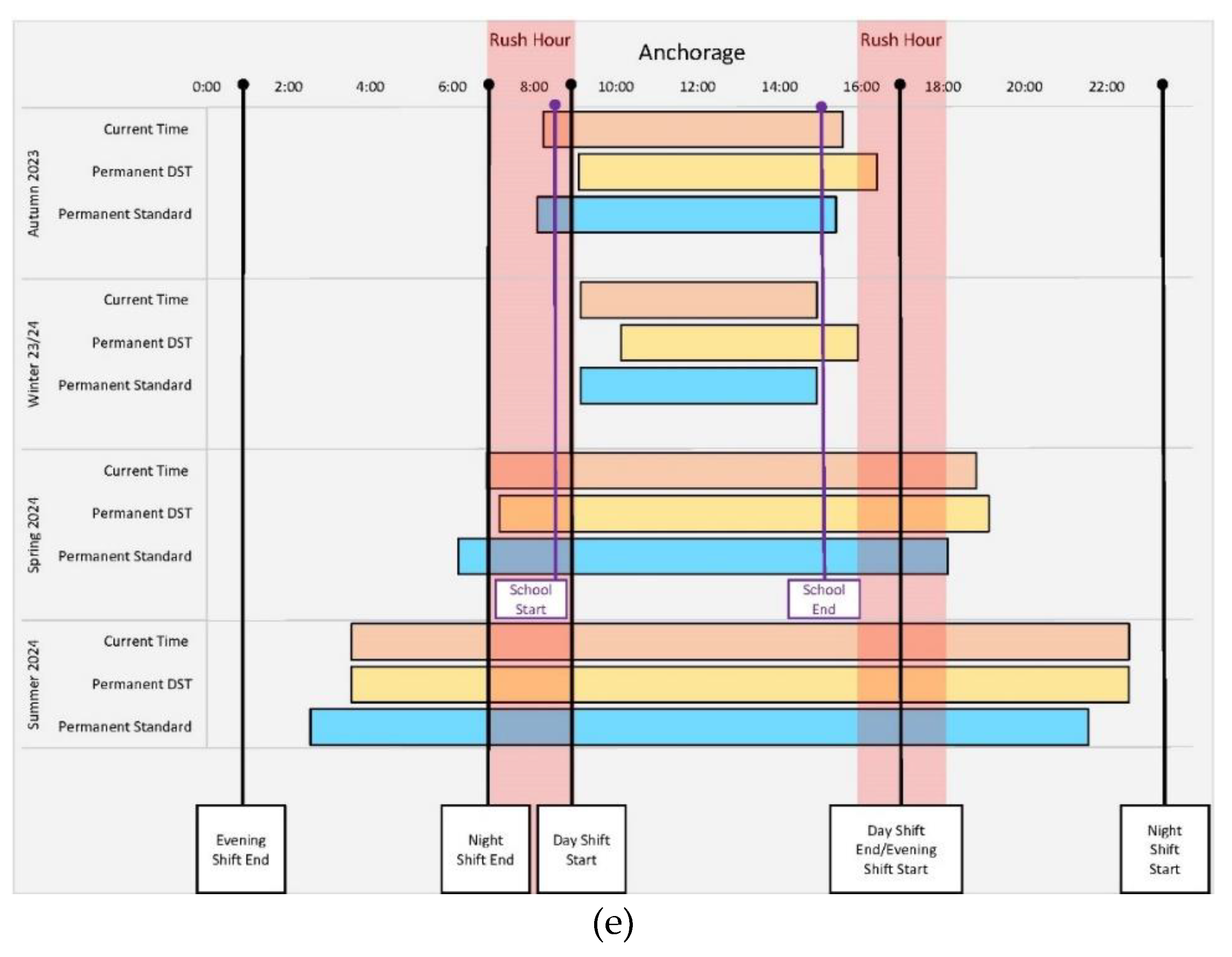
| Shift Type | Shift Start Time | Shift End Time | Expected Morning Waketime | Average Expected Sleep Duration per 24 hours (in mins) |
|---|---|---|---|---|
| Day | 09:00 | 17:00 | 07:16±00:04 | 482±45 |
| Evening | 17:00 | 01:00 | 07:25±00:04 | 363±60 |
| Night | 23:00 | 07:00 | 07:53±00:06 | 338±43 |
| School | 08:10±00:17 | 14:45±00:27 | 07:14±00:04 | 460±67 |
| CTA (M±SD) |
Permanent DST (M±SD) |
Permanent ST (M±SD) |
F(2, 74) value | P value | η2 (95% CI) | |
|---|---|---|---|---|---|---|
| Average Sunrise | 07:08±02:48 | 07:35±03:18 | 06:42±03:18 | 387.24 | <0.001** | 0.84 (0.79-0.87) |
| Distance between Sunrise and Waketime‡ | 19±69 minutes | -15±86 minutes | 44±86 minutes | 406.82 | <0.001** | 0.85 (0.80-0.87) |
| Percentage of Waketimes Occurring Before Sunrise | 42%±37% | 63%±41% | 33%±38% | 76.37 | <0.001** | 0.51 (0.39-0.59) |
| Percent Darkness During the Total Waking Day | 32%±13% | 29%±13% | 33%±12% | 94.69 | <0.001** | 0.56 (0.45-0.64) |
| Percent Darkness During Commute-to-work | 28%±44% | 32%±45% | 28%±44% | 6.48 | 0.002* | 0.08 (0.01-0.17) |
| Percent Darkness During Work Day | 41%±42% | 41%±42% | 41%±42% | 0.08 | 0.93 | 0.001 (0.00-0.01) |
| Percent Darkness During Commute Home | 31%±44% | 30%±45% | 31%±44 | 0.37 | 0.68 | 0.005 (0.00-0.04) |
| Percent Darkness During Sleep | 66%±24% | 71%±26% | 63%±24% | 103.11 | <0.001** | 0.58 (0.48-0.65) |
| CTA (M±SD) | Permanent DST (M±SD) |
Permanent ST (M±SD) |
F(2, 74) value | P value | η2 (95% CI) | |
|---|---|---|---|---|---|---|
| Commute-to-work Average Effectiveness |
96.02±3.27 | 96.12±3.12 | 96.12±3.14 | 9.50 | 0.001** | 0.11 (0.03-0.21) |
| Commute-to-work Minimum Effectiveness |
94.94±3.87 | 95.04±3.73 | 95.04±3.75 | 8.24 | 0.004* | 0.10 (0.02-0.19) |
| Work Day Average Effectiveness | 91.21±10.76 | 91.32±10.60 | 91.33±10.61 | 11.40 | <0.001** | 0.13 (0.04-0.23) |
| Work Day Minimum Effectiveness | 86.70±12.32 | 86.84±12.13 | 86.83±12.13 | 4.82 | 0.009* | 0.06 (0.004-0.14) |
| Commute Home Average Effectiveness |
87.36±11.83 | 87.50±11.64 | 87.49±11.63 | 3.37 | 0.04* | 0.04 (0.00-0.12) |
| Commute Home Minimum Effectiveness |
86.31±11.93 | 86.45±11.75 | 86.44±11.75 | 3.23 | 0.04* | 0.04 (0.00-0.11) |
| Total Waking Day Average Effectiveness |
93.60±5.99 | 93.63±5.98 | 93.63±5.98 | 9.19 | <0.001** | 0.11 (0.03-0.20) |
| Total Waking Day Minimum Effectiveness |
89.45±5.91 | 89.48±5.90 | 89.48±5.89 | 24.26 | <0.001** | 0.25 (0.13-0.35) |
| CTA (M±SD) |
Permanent DST (M±SD) |
Permanent ST (M±SD) |
F value | P value | η2 (95% CI) | |
|---|---|---|---|---|---|---|
| Morning Rush Hour Average Effectiveness | 87.89±14.37 | 88.05±14.15 | 88.07±14.16 | F(2, 54)= 3.14 | 0.05 ⴕ | 0.05 (0.00-0.14) |
| Morning Rush Hour Minimum Effectiveness | 86.92±14.22 | 87.06±14.00 | 87.09±14.00 | F(2, 54)= 2.90 | 0.06ⴕ | 0.05 (0.00-0.14) |
| Percent Darkness During Morning Rush Hour | 7%±23% | 16%±31% | 7%±23% | F(2, 54)= 14.35 | <0.001** | 0.21 (0.08-0.33) |
| Evening Rush Hour Average Effectiveness | 97.48±0.92 | 97.50±0.90 | 97.49±0.91 | F(2, 39)= 0.54 | 0.58 | 0.01 (0.00-0.08) |
| Evening Rush Hour Minimum Effectiveness | 97.11±0.68 | 97.12±0.66 | 97.12±0.67 | F(2, 39)= 0.51 | 0.60 | 0.01 (0.00-0.08) |
| Percent Darkness During Evening Rush Hour | 7%±14% | 0%±0% | 7%±15% | F(2, 39)= 8.80 | <0.001** | 0.18 (0.33-0.62) |
Disclaimer/Publisher’s Note: The statements, opinions and data contained in all publications are solely those of the individual author(s) and contributor(s) and not of MDPI and/or the editor(s). MDPI and/or the editor(s) disclaim responsibility for any injury to people or property resulting from any ideas, methods, instructions or products referred to in the content. |
© 2023 by the authors. Licensee MDPI, Basel, Switzerland. This article is an open access article distributed under the terms and conditions of the Creative Commons Attribution (CC BY) license (http://creativecommons.org/licenses/by/4.0/).





